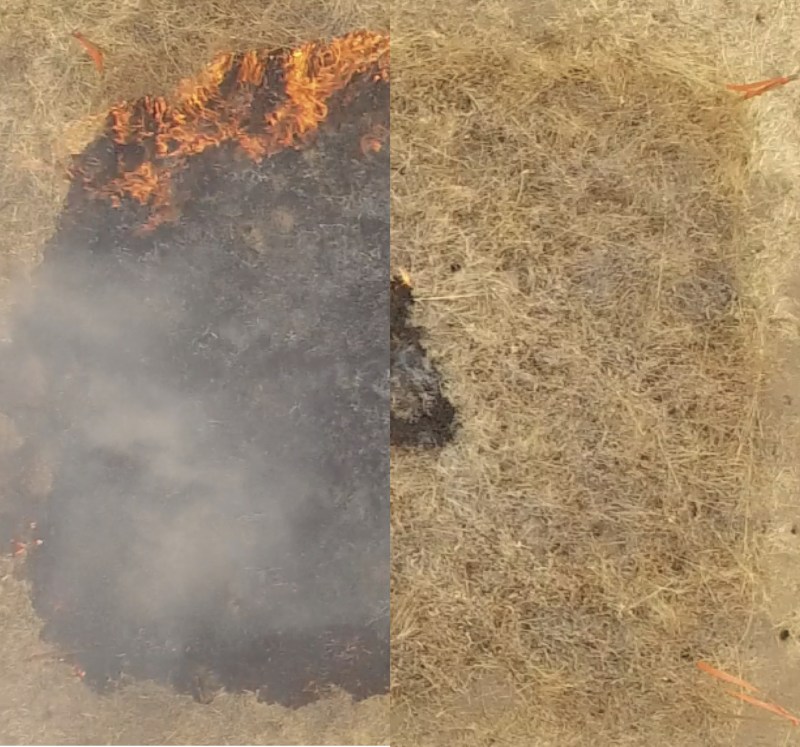This is the second in a series The Daily is publishing on wildfires and their impact at campus and in the local community.
A novel gel-like fluid developed by Stanford researchers could help alleviate California’s wildfire crisis by preventing fires in high-risk areas from starting in the first place.
The fluid, an environmentally-benign suspension of fire retardant in a water-based gel known as a hydrogel would only need to be applied once to high-risk areas, including certain roads and near utility infrastructure, before the beginning of California’s fire season in the fall. The key to the material’s success lies in its ability to form films on vegetation that can survive weathering, thus lasting longer than conventional retardants.
Eric Appel, a materials science and engineering associate professor, is the senior author on a study recently published about the retardant. He likened the task of battling fires to battling an illness in the body.
“What we do now is effectively the same as treatment. You’re sick, — a fire [has] already started — and we are trying to address your illness,” Appel said. “What we’re trying to do is enable prevention [and] stop the fires from occurring in the first place.”
“All the retardants that are used currently are only used reactively — you wait for fires to start, and then we use the retardants to try and corral them or put them out in some way,” Appel added.
Appel provided two reasons why current retardants are not used preemptively. The first was that current retardants aren’t typically capable of withstanding weathering.
“So it’s not the kind of thing you can go out and pre-treat some areas; you have to keep treating throughout the year to maintain protective barrier against fires,” he said. “Dry vegetation tends to be hydrophobic, so with current retardants, only about 40% of what is sprayed actually sticks because the rest beads up and rolls off.”
Appel estimates that the new gel-like fluid his team developed will stick 70% of the time.
The second reason, Appel said, is that “no one had really looked at where fires were starting.”
Appel pointed to previous reports concluding that roughly 95% of fires are started by people, but when Appel and his team did similar analyses at the beginning of their study, they found that 84% of all fires in the last 10 years in California started after roadside accidents or utilities infrastructure malfunction near “high risk areas.”
Armed with this insight, Appel and his team set out to design their gel-like fluid.
“If you know where the fires are starting, there’s an opportunity to pre-treat them,” Appel said. “That’s what got us to go into the lab and try to develop a retardant that would not just have improved adherence to vegetation but also improved retention, so a single treatment can provide protection for an entire season.”
According to materials science and engineering Ph.D. student, Anthony Yu, pre-treating fires can have economic benefits too.
“You can put 20,000 gallons of this on an area for prevention, or one million gallons of the traditional formulation after a fire starts,” Yu told Stanford News.
The money saved from fighting blazes can then be put directly towards further prevention.
“If you look at the fire numbers we’re talking about — we see five or seven make the news, but there’s something like 30,000 fires a year in California,” Appel said. All of those can add up in terms of cost, so Appel hopes that
“this technology could cut down on those fires and free up resources for other preventative methods, like better forest management.”
With the cost of fighting fires soaring to an all-time high, California regulators, homeowners and corporations could all save money by switching to a new fire retardant.
“The implications are that there is now a tool available for communities, fire departments, Caltrans, the military, the Bureau of Land Management,” Appel said. “So local, state and federal agencies as well as private homeowners have a tool at their disposal to pre-treat areas that are known to cause ignitions.”
Given the recent scrutiny of utility companies such as PG&E and their role in the wildfires, the gel-like fluid could provide utilities with a higher-tech alternative to current strategies such as forced power shutoffs, which may be necessary in especially windy and dry weather but often end up putting individuals in inconvenient or vulnerable positions due to the lack of power.
“A lot of the utilities have been focusing on hardening their equipment so it doesn’t spark as much, but our treatment would enable a single annual treatment to harden the vegetation around it,” Appel said.
Contact Ujwal Srivastava at ujwal ‘at’ stanford.edu.
